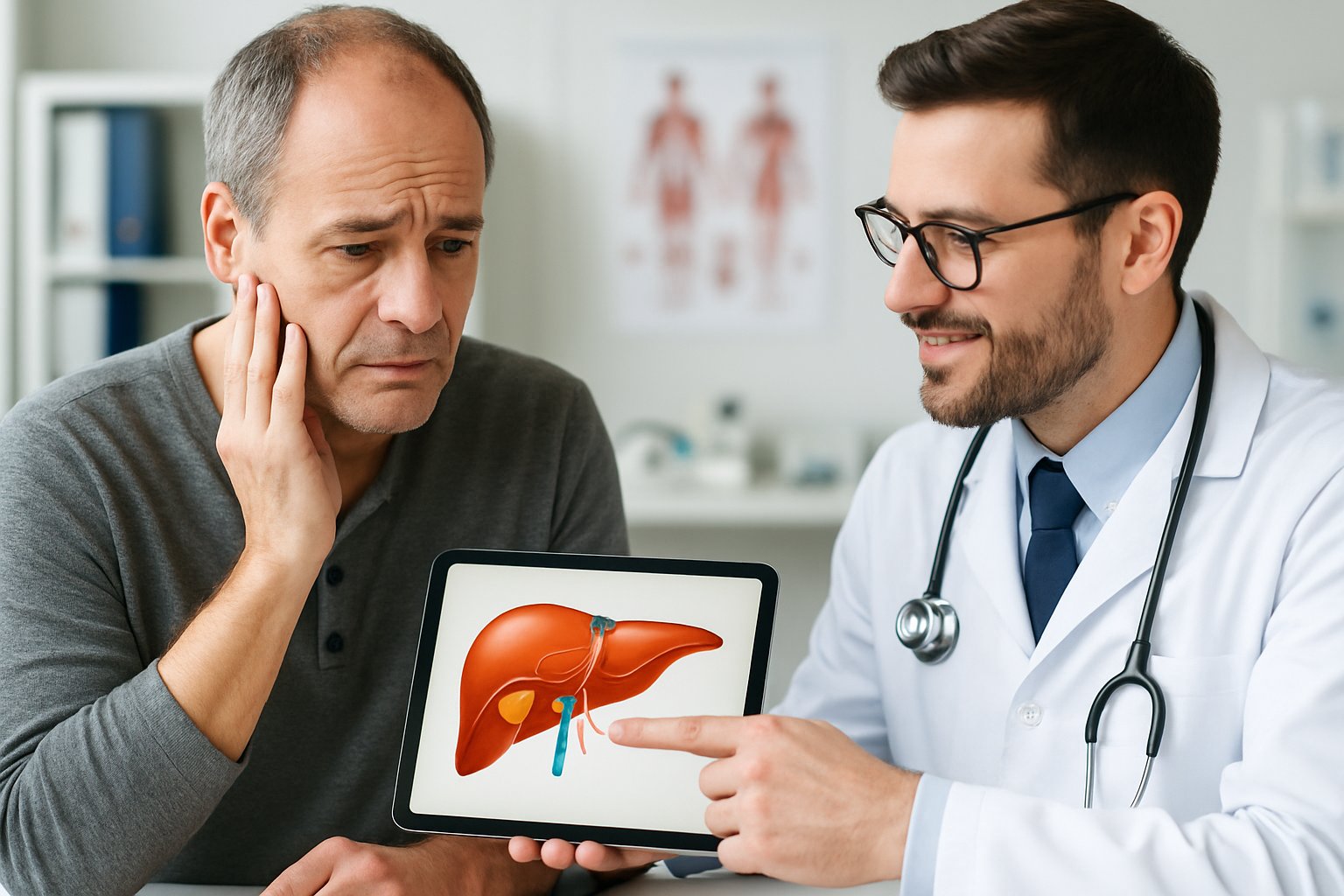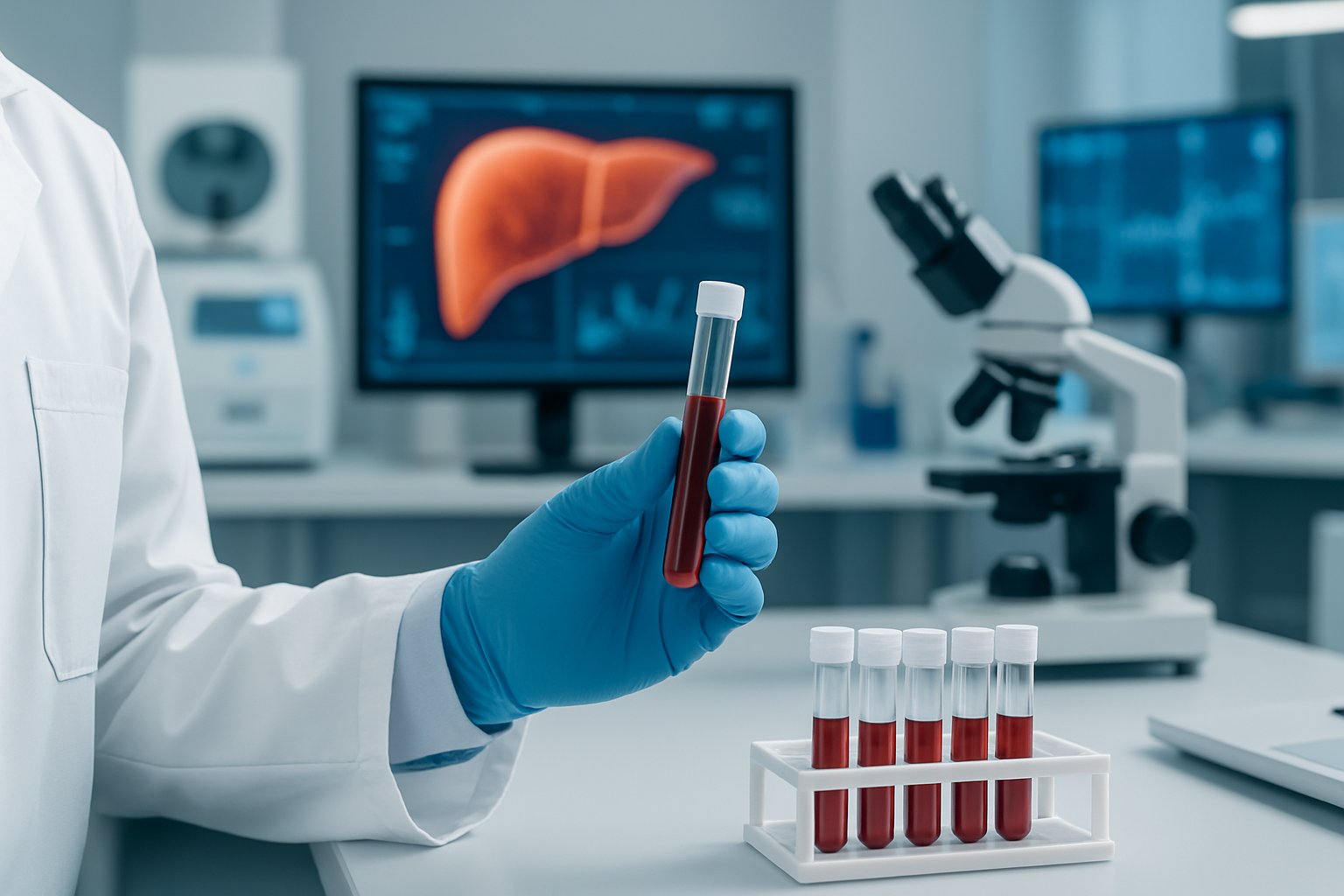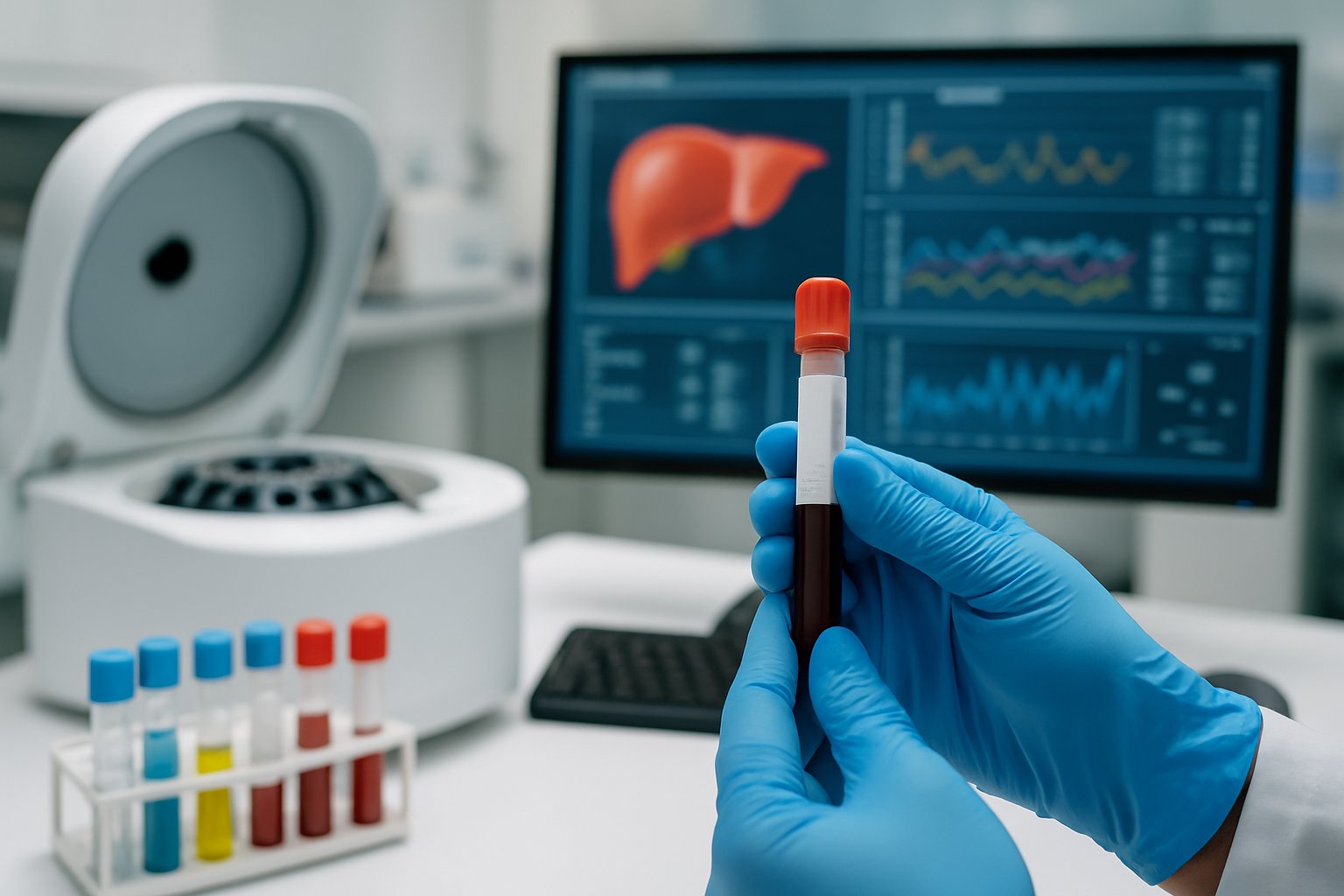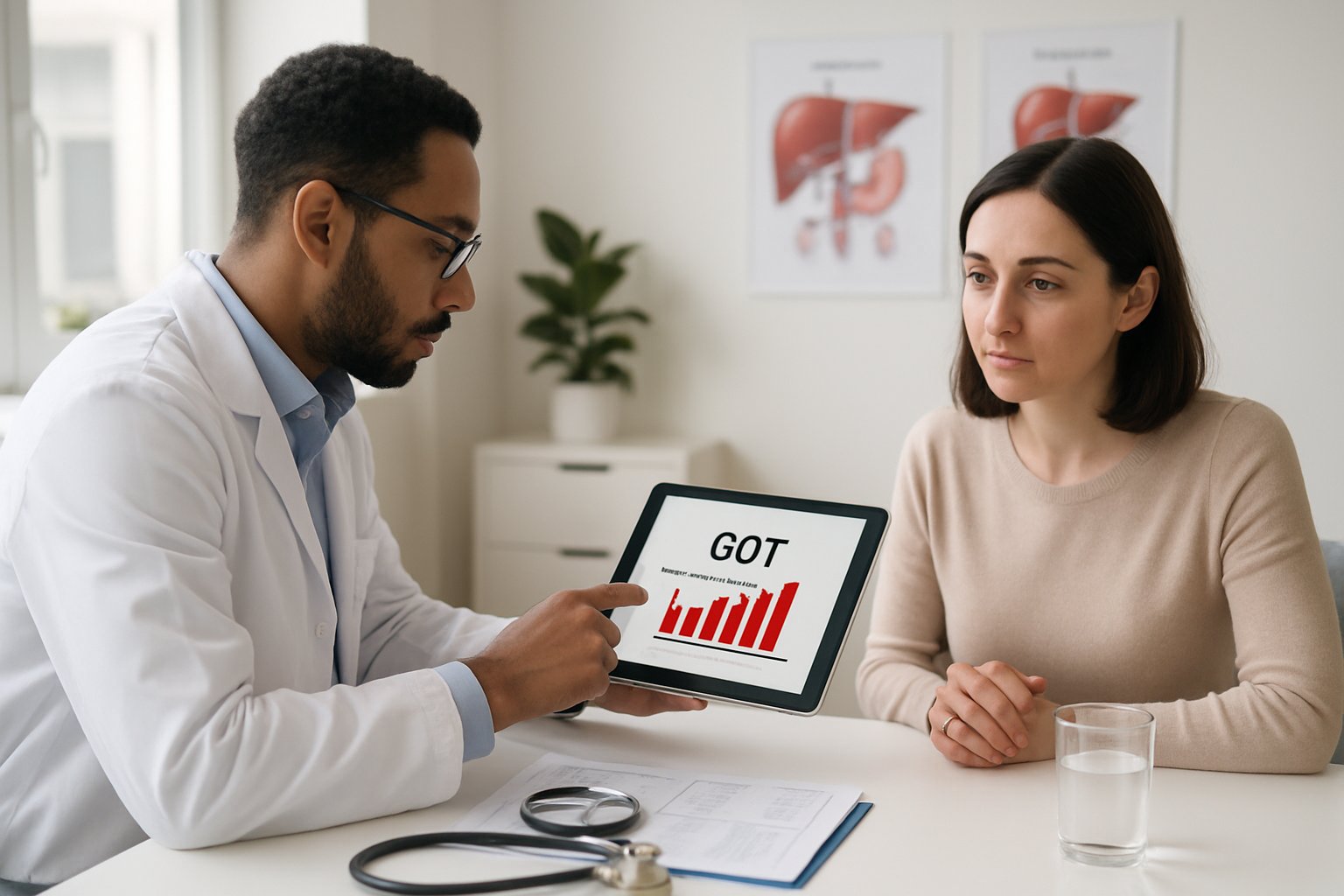When serum GGT levels are high, it typically signals liver problems, excessive alcohol use, or other health conditions that cause cellular damage. High GGT levels indicate increased oxidative stress in the body and can point to liver disease, bile duct problems, or elevated risk for heart disease and other serious conditions.

Gamma-glutamyl transferase (GGT) is an enzyme[1] found throughout the body, with the highest concentrations in the liver, kidneys, and gallbladder. This enzyme plays a crucial role in breaking down glutathione, the body’s most important antioxidant, and helps process toxins and medications.
Elevated GGT doesn’t directly cause disease, but it serves as an early warning system for various health problems. Understanding what triggers high GGT levels and how to address them can help people take proactive steps to protect their liver and overall health.
Key Takeaways
- High GGT levels usually indicate liver problems, excessive alcohol consumption, or increased oxidative stress in the body
- GGT blood tests help doctors diagnose liver and bile duct conditions[2] and monitor overall health status
- Reducing alcohol intake, eating more fruits and vegetables, and treating underlying conditions can help lower elevated GGT levels
What Is GGT and Its Role in the Body

GGT is a liver enzyme that plays a key role in protecting cells and breaking down substances in the body. This enzyme works mainly with glutathione, a powerful antioxidant that helps remove harmful toxins.
Gamma-Glutamyl Transferase Explained
Gamma-glutamyl transferase (GGT) is an enzyme[3] found throughout the human body. It sits on cell surfaces and helps speed up chemical reactions.
The liver contains the highest levels of this enzyme. However, GGT also appears in the kidneys, pancreas, heart, and brain in smaller amounts.
Key locations of GGT:
- Liver (highest concentration)
- Kidneys
- Pancreas
- Heart
- Brain
- Bile ducts
The enzyme gets its name from its ability to transfer gamma-glutamyl groups between molecules. This transfer process is essential for many body functions.
Function of GGT in Liver Metabolism
GGT serves as an important marker for liver health. The liver enzyme helps protect cells from damage[4] by working with the body’s natural defense systems.
The enzyme plays a crucial role in bile acid metabolism. When bile ducts become blocked or damaged, GGT levels rise in the blood.
Primary liver functions of GGT:
- Processing bile acids
- Breaking down toxins
- Supporting cell protection
- Maintaining liver cell health
GGT also helps the liver process medications and alcohol. When the liver works harder to break down these substances, more GGT gets released into the bloodstream.
GGT and Glutathione Metabolism
GGT has a special relationship with glutathione, the body’s most important antioxidant. The enzyme breaks down glutathione outside of cells so the parts can be reused.
Glutathione protects cells from oxidative stress and harmful free radicals. GGT helps recycle this valuable compound by splitting it into smaller pieces.
GGT’s role in glutathione processing:
- Breaks down glutathione molecules
- Releases amino acid building blocks
- Allows cells to rebuild new glutathione
- Maintains antioxidant balance
This recycling process is vital for cell health. Without proper GGT function, cells would struggle to maintain adequate glutathione levels for protection against damage.
Understanding the GGT Blood Test
A GGT blood test measures the level of the enzyme gamma-glutamyl transferase[2] to check liver health and detect bile duct problems. The test requires minimal preparation and provides results that doctors interpret alongside other liver enzymes to get a complete picture of liver function.
GGT Test Procedure and Preparation
The GGT test uses a simple blood draw from a vein in the arm. Most labs draw blood in the morning, though timing is not critical for accurate results.
Patients should avoid alcohol for at least 24 hours before the test. Alcohol consumption can raise GGT levels and affect test accuracy.
Medications that may affect results include:
- Anti-seizure drugs
- Blood thinners
- Some antibiotics
- Acetaminophen
Patients should tell their doctor about all medications and supplements they take. The doctor will decide if any need to be stopped before testing.
No fasting is required for a standard GGT test. However, if the doctor orders a complete liver panel, fasting may be necessary.
The blood draw takes less than five minutes. Results are typically available within one to two days.
Normal GGT Range and Reference Values
Normal GGT levels vary by age and gender. Men typically have higher levels than women at all ages.
Typical normal ranges include:
- Adult men: 10-71 U/L
- Adult women: 6-42 U/L
- Children: Lower than adult values
These ranges can differ between laboratories. Each lab provides its own reference values with test results.
Age, gender, exercise, weight, pregnancy, diet, and medications can all influence GGT levels[1]. What counts as normal depends on these individual factors.
Values in the upper half of the normal range may still indicate increased health risks. Some doctors prefer GGT levels in the lower half of the normal range.
Pregnancy can lower GGT levels temporarily. Newborns have higher levels that decrease as they grow.
Interpreting GGT With Other Liver Function Tests
Doctors rarely use GGT alone to diagnose liver problems. They combine it with other liver function tests for better accuracy.
Common liver panel tests include:
- ALT (alanine aminotransferase): Shows liver cell damage
- AST (aspartate aminotransferase): Indicates liver or muscle damage
- ALP (alkaline phosphatase): Rises with liver or bone problems
GGT helps distinguish between liver and bone disease when alkaline phosphatase is high[1]. High GGT plus high ALP suggests liver or bile duct problems. Normal GGT with high ALP points to bone disease.
The pattern of enzyme elevations helps doctors identify specific conditions. Viral hepatitis typically raises ALT and AST more than GGT. Bile duct blockages raise GGT and ALP significantly.
Alcohol-related liver damage often shows high GGT with moderately elevated ALT and AST. This pattern helps doctors identify alcohol abuse[1] even when patients do not report drinking.
Causes of Elevated GGT Levels

High GGT levels typically indicate problems with the liver or bile ducts. The most common causes include liver disease from various sources and blockages in the bile duct system.
Liver Disease and Liver Damage
Liver diseases significantly increase GGT levels[1] in the blood. The liver produces most of the body’s GGT, so any damage to liver cells causes more of this enzyme to leak into the bloodstream.
Common liver conditions that raise GGT include:
- Hepatitis (viral, alcoholic, or drug-induced)
- Cirrhosis
- Fatty liver disease
- Liver cancer
Alcohol abuse is one of the leading causes of elevated GGT. Prolonged alcohol use raises GGT levels[1] because alcohol damages liver cells directly.
Even moderate drinking can cause slight increases in GGT. The enzyme levels usually return to normal within 2 to 6 weeks after stopping alcohol completely.
Drug toxicity can also damage the liver and increase GGT. Certain medications like older seizure drugs raise GGT levels as a side effect.
Bile Duct Obstruction and Biliary Issues
High levels of GGT are found in patients with biliary tract disease[1]. Bile duct problems prevent bile from flowing normally, causing GGT to build up in the blood.
Common bile duct issues include:
- Gallstones blocking ducts
- Inflammation of bile ducts
- Bile duct injuries or infections
- Cysts in the bile system
- Cancer affecting bile ducts
Doctors often test GGT along with alkaline phosphatase to diagnose bile duct problems. When both enzymes are high, it points to liver or bile duct disease rather than bone problems.
Cholestasis occurs when bile flow slows or stops completely. This condition causes GGT levels to rise significantly as the enzyme backs up in the liver and spills into the bloodstream.
Medical Conditions Linked to High GGT
High GGT levels often signal damage to the liver, bile ducts, or other organs. Liver and bile duct conditions[2] are the most common causes, while heart and pancreatic problems can also raise GGT levels.
Fatty Liver Disease and Cirrhosis
Fatty liver disease occurs when too much fat builds up in liver cells. This condition commonly raises GGT levels because the liver works harder to process toxins and maintain normal function.
Non-alcoholic fatty liver disease affects people who drink little or no alcohol. It often develops in patients with diabetes, obesity, or high cholesterol. The liver becomes inflamed as fat accumulates.
Alcoholic fatty liver disease results from heavy drinking over time. Even moderate alcohol use can contribute to fat buildup in liver cells.
Cirrhosis represents advanced liver scarring from long-term damage. GGT levels increase in patients with cirrhosis[1] because healthy liver tissue gets replaced by scar tissue.
The scarred liver cannot filter blood effectively. This forces remaining healthy cells to work harder, which raises enzyme levels in the blood.
Key warning signs include:
- Fatigue and weakness
- Abdominal swelling
- Yellowing of skin or eyes
- Easy bruising or bleeding
Hepatitis and Inflammatory Liver Disorders
Hepatitis means inflammation of the liver from various causes. Elevated GGT levels are found in patients with liver diseases such as hepatitis[1] because inflammation damages liver cells.
Viral hepatitis includes hepatitis A, B, and C infections. These viruses attack liver cells directly, causing widespread inflammation and cell death.
Autoimmune hepatitis happens when the body’s immune system attacks healthy liver tissue. This creates ongoing inflammation that steadily damages the organ.
Drug-induced hepatitis can result from medications like acetaminophen, antibiotics, or herbal supplements. The liver struggles to process these substances, leading to toxic buildup.
Inflammation makes liver cells leak enzymes into the bloodstream. GGT levels often stay high until the underlying inflammation resolves.
Common symptoms include:
- Dark urine and pale stools
- Nausea and vomiting
- Loss of appetite
- Joint pain and fever
Heart Failure and Pancreatitis
Heart failure increases the risk of elevated GGT levels[1] even when values fall within normal ranges. The heart cannot pump blood effectively, which affects liver function.
Congestive heart failure causes blood to back up into the liver. This creates pressure that damages liver cells and raises enzyme levels.
Poor blood flow reduces oxygen delivery to the liver. Liver cells become stressed and release more GGT into the bloodstream.
Pancreatitis involves inflammation of the pancreas, which produces digestive enzymes. Acute pancreatitis can raise GGT levels because the pancreas and liver share some enzyme pathways.
Chronic pancreatitis develops from repeated episodes of inflammation. The damaged pancreas affects nearby organs, including the liver and bile ducts.
Risk factors include:
- High blood pressure
- Previous heart attacks
- Heavy alcohol use
- Gallstones blocking pancreatic ducts
Both conditions require immediate medical attention to prevent serious complications.
Lifestyle and External Factors Affecting GGT
Several lifestyle choices and external factors can significantly impact GGT levels in the blood. Alcohol consumption, certain medications, and metabolic conditions are the primary drivers of elevated readings.
Alcohol Consumption and GGT Elevation
Alcohol consumption is one of the strongest predictors of elevated GGT levels. Prolonged alcohol use raises GGT levels[1] in most people who drink regularly.
The relationship between alcohol and GGT is dose-dependent. People who drink more alcohol show higher GGT readings than those who drink less.
GGT Response to Alcohol:
- Light drinking: Slight elevation above normal
- Moderate drinking: Noticeable increase in levels
- Heavy drinking: Significant elevation often 2-3 times normal
GGT levels increase as drinking increases[1]. This makes the test useful for identifying alcohol abuse in medical settings.
Alcohol cessation can reverse these changes. GGT levels return to normal after 2 to 6 weeks[1] of stopping alcohol use completely.
The liver produces most GGT in the bloodstream. Alcohol damages liver cells and increases the enzyme release into circulation.
Medications That Can Raise GGT
Many common medications can elevate GGT levels as a side effect. Patients should inform their doctors about all medications before GGT testing.
Medications that commonly increase GGT:
- Phenytoin and other older seizure medications
- Phenobarbital
- Carbamazepine
- Some NSAIDs with prolonged use
Several medications increase GGT levels[1] and doctors must consider this when reading test results. Anti-seizure drugs are particularly known for causing significant elevations.
The mechanism involves increased enzyme production in liver cells. These medications activate certain pathways that boost GGT creation.
Patients taking these drugs may need baseline GGT testing. This helps doctors distinguish between medication effects and actual liver problems.
Metabolic Syndrome and Type 2 Diabetes
Metabolic syndrome strongly correlates with elevated GGT levels. This condition includes insulin resistance, high blood pressure, abnormal blood fats, and excess weight around the waist.
Elevated levels of GGT increased the risk of metabolic syndrome[1] in multiple studies. The relationship appears independent of other risk factors.
Type 2 diabetes may also connect to higher GGT readings. However, research shows mixed results on this relationship.
Factors that help reduce GGT in metabolic conditions:
- Weight loss through calorie reduction
- Balanced diet rich in fruits and vegetables
- Regular exercise and physical activity
- Blood sugar control in diabetic patients
Eating fruits and vegetables 10-11 times per week lowered GGT levels[1] over 10 years in one large study. Physical activity helps by improving liver function and reducing inflammation.
The connection likely involves oxidative stress and inflammation. Metabolic syndrome creates cellular damage that increases GGT production and release.
Symptoms, Risks, and Management of High GGT

High GGT levels often develop without obvious symptoms but can signal serious health risks including heart disease, liver damage, and increased mortality. Understanding warning signs and taking steps to reduce GGT through lifestyle changes can help protect long-term health.
Recognizing Common Symptoms and Signs
Most people with elevated GGT levels do not experience direct symptoms from the enzyme itself. The symptoms that appear usually come from underlying conditions causing the high levels.
Liver-related symptoms may include:
- Fatigue and weakness
- Jaundice (yellowing of skin and eyes)
- Dark urine
- Light-colored stools
- Abdominal pain in the upper right area
General signs that warrant attention:
- Unexplained tiredness
- Loss of appetite
- Nausea or vomiting
- Swelling in legs or abdomen
Since high GGT levels point to oxidative stress[1] in the body, people may feel generally unwell without specific symptoms. Many individuals only discover elevated levels through routine blood work.
Healthcare providers often order GGT tests when other liver function tests[2] show abnormal results. The test helps determine if liver problems are present when alkaline phosphatase levels are also high.
Short-Term and Long-Term Health Risks
Elevated GGT creates both immediate concerns and serious long-term health threats. The risks increase even when levels fall within the normal range but toward the higher end.
Cardiovascular risks pose the greatest long-term danger:
- Increased risk of coronary heart disease[1]
- Higher chance of heart failure
- Greater risk of stroke in men[1]
- Elevated blood pressure risk
Cancer risks also increase significantly:
- Higher overall cancer risk
- Increased breast cancer risk[1] in women
- Greater esophageal cancer risk
- Worse outcomes for liver and endometrial cancers
Metabolic complications include:
- Type 2 diabetes risk
- Metabolic syndrome development
- Chronic kidney disease potential
GGT contributes to oxidative stress[1] by breaking down glutathione, the body’s main antioxidant. This process creates toxic molecules that damage tissues, cells, and DNA over time.
Steps to Lower GGT and Support Liver Health
Reducing GGT levels requires addressing underlying causes and making targeted lifestyle changes. Most people can see improvements within 2-6 weeks of consistent efforts.
Stop alcohol consumption immediately:
- Complete abstinence provides the best results[1]
- Even moderate drinking elevates GGT levels
- Levels typically normalize within 6 weeks
Dietary modifications that help:
- Eat fruits and vegetables 10-11 times per week[1]
- Reduce red meat consumption
- Drink coffee regularly
- Increase antioxidant-rich foods
Medical management steps:
- Review medications with healthcare providers
- Treat underlying liver or heart conditions
- Monitor thyroid hormone levels
- Address any bile duct problems
Lifestyle changes include:
- Quit smoking cigarettes
- Maintain healthy body weight
- Exercise regularly
- Manage stress levels
Working with healthcare providers ensures proper treatment of conditions causing elevated GGT. Regular monitoring helps track progress and adjust treatment plans as needed.
Frequently Asked Questions

Elevated GGT levels raise important questions about health risks, underlying causes, and treatment options. Understanding the serious implications of dangerously high levels and available strategies for reduction helps patients make informed decisions about their health.
What are the health implications of a GGT level considered dangerously high?
Dangerously high GGT levels indicate severe oxidative stress and potential organ damage. Elevated GGT levels increase the risk of heart disease, stroke, and death[1] from various causes.
The cardiovascular system faces significant threats from extremely high GGT. Higher GGT levels are linked to coronary heart disease and sudden cardiac death[1].
Liver damage becomes more likely as GGT reaches dangerous levels. The enzyme indicates ongoing cellular destruction and reduced ability to process toxins effectively.
Kidney function may decline with persistently high GGT levels. Some studies show increased risk of chronic kidney disease in patients with elevated enzyme levels.
Could elevated GGT levels be indicative of cancer?
Elevated GGT levels increase overall cancer risk according to clinical studies[1]. The enzyme serves as a potential predictor for various cancer types.
Breast cancer risk increases in women with higher GGT levels[1]. Research involving over 230,000 women showed this connection across multiple breast cancer subtypes.
Esophageal cancer risk rises even with GGT levels considered normal[1]. Korean research found increased risk starting at levels above 18 U/L.
Liver cancer patients with higher GGT levels face worse outcomes. The enzyme correlates with disease progression and survival rates.
What are the possible causes of a GGT level exceeding 200?
Severe liver disease often causes GGT levels over 200. Cirrhosis, hepatitis, and advanced fatty liver disease produce these extremely high readings.
Chronic alcohol abuse frequently elevates GGT to dangerous levels. Prolonged alcohol use raises GGT levels significantly[1].
Biliary tract obstructions can spike GGT dramatically. Gallstones, tumors, or severe inflammation block bile flow and damage liver cells.
Certain medications push GGT above 200. Anti-seizure drugs like phenytoin and phenobarbital commonly cause these elevations.
What can be done to lower elevated GGT levels?
Complete alcohol abstinence provides the most effective GGT reduction[1]. Levels typically return to normal within 2 to 6 weeks of stopping alcohol consumption.
Eating fruits and vegetables 10-11 times per week lowers GGT levels[1]. The natural antioxidants help reduce oxidative stress and enzyme elevation.
Treating underlying liver conditions directly impacts GGT levels. Addressing hepatitis, fatty liver disease, or biliary problems reduces enzyme production.
Coffee consumption may help lower GGT levels. Studies in Japanese men showed reduced enzyme levels with regular coffee drinking.
Is it possible to have high GGT levels even if all other liver function tests are normal?
High GGT with normal other liver tests occurs frequently. GGT responds to different conditions than traditional liver enzymes like ALT and AST.
Alcohol consumption raises GGT specifically without affecting other liver markers initially. This makes GGT particularly useful for detecting alcohol-related liver stress.
Heart disease and diabetes can elevate GGT independently of liver function. These conditions increase oxidative stress throughout the body.
Medications may selectively raise GGT while leaving other liver enzymes normal. Anti-seizure drugs commonly cause this isolated elevation pattern.
What symptoms might one experience with significantly high GGT levels?
High GGT itself rarely causes direct symptoms. The underlying conditions causing the elevation typically produce the noticeable effects.
Liver disease symptoms include fatigue, abdominal pain, and jaundice. Nausea, loss of appetite, and dark urine may also occur with liver problems.
Biliary tract disease causes right upper abdominal pain and yellowing of skin or eyes. Pale stools and itching frequently accompany bile duct problems.
Heart-related symptoms may appear with very high GGT levels. Chest pain, shortness of breath, or irregular heartbeat warrant immediate medical attention.
References
- 21 Causes of Elevated GGT + Proven Ways to Reduce It. https://labs.selfdecode.com/blog/elevated-ggt/ Accessed October 27, 2025
- Gamma-Glutamyl Transferase (GGT) Test: What It Is & Results. https://my.clevelandclinic.org/health/diagnostics/22055-gamma-glutamyl-transferase-ggt-test Accessed October 27, 2025
- Gamma-glutamyl Transferase (GGT) Test: MedlinePlus Medical Test. https://medlineplus.gov/lab-tests/gamma-glutamyl-transferase-ggt-test/ Accessed October 27, 2025
- Gamma-Glutamyl Transferase (GGT) Test: What It Is & Results. https://my.clevelandclinic.org/health/diagnostics/22055-gamma-glutamyl-transferase-ggt-test/ Accessed October 27, 2025
